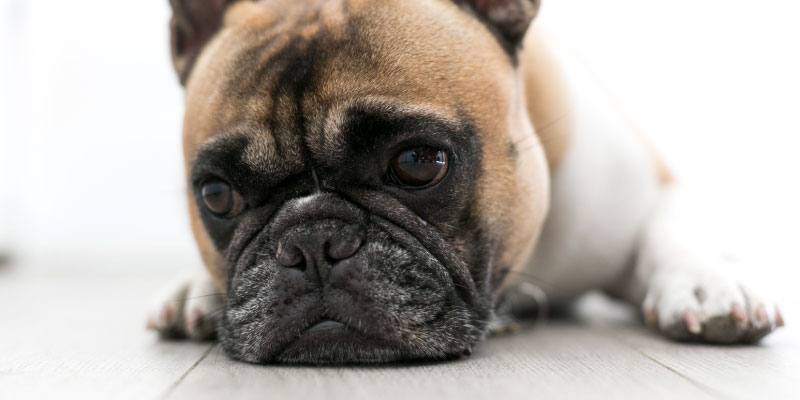They call them man’s best friend for a reason. With an in-built pack mentality, dogs are innately loyal to their owners, and behave this way not just for love and affection, but as a survival instinct.
It’s for this reason that you might find your dog gets particularly sad when you’re away. Some might begin to exhibit signs as soon as they see a suitcase, or others when you leave for work in the morning.

Love it or hate it, we all have to leave our dogs at times, so how can we deal with dog separation anxiety?
First of all, we need to understand the difference between ‘grumbling’ and true separation anxiety.
What is separation anxiety in dogs?
There is no conclusive medical evidence as to what causes separation anxiety in dogs.
However, some theorists say it may be more common in rescue dogs, who may have become attached to one owner from a young age only to be separated and given away. It’s also true that some dog breeds, specifically toy breeds, are more prone to separation anxiety than other.
Alternatively, if there has been a death in the family or even a house move, these could all be triggers. In short, when you first bring your puppy home, you never know how they’ll react to being left alone.
Separation anxiety is characterised by a certain set of behaviours seen only when your dog is left alone. It’s important, however, to distinguish between dog anxiety when left alone and other potential medical problems.
Many will share the same symptoms, for example excessive urination/defecation, so always visit your vet if you’re not sure.
Signs of anxiety to look out for
When it comes to separation anxiety, leaving dogs at home can be stressful not just for your pup, but for you too. This is because your dog could exhibit any of the following disruptive behaviours, making leaving them and coming home stressful for you both.
Toilet issues
If your dog is usually well house trained, a sign of anxiety could be excessive urination or defecation around the house. Try not to chastise your dog for this – take them outdoors as often as you can and clean the area with a strong pet disinfectant, so that they don’t associate it with toilet activities.
Destructive behaviour
One of the most common signs of separation anxiety, is destructive behaviour that may involve chewing and ripping furniture, or attacking the door from which you left. If left untreated, this could cause harm to your dog, such as broken teeth, and it’s costly to repair the damage.
Excessive barking/howling
Once you get to know your dog, you’ll identify the different kind of barks that he/she exhibits. If you begin to hear a new kind of howl or have complaints from the neighbours, this could be a sign of anxiety. You shouldn’t hear this kind of bark at any other time.
Self-mutilation
This is less common, but nevertheless a big concern for dog owners. If your dog is biting, licking or or scratching itself when you’re away, you may need to consider natural dog calming aids or other solutions. If left untreated, this can turn into a compulsive behaviour and create long term damage in your dogs limbs.
Vomiting/coprophagia
This is perhaps the most extreme and certainly not common. It may be hard to spot as it will not take place when you’re in the house, so consider buying a ‘nanny cam’ to spot signs of coprophagia. This is when the dog eats its own waste. If you’re concerned about this, talk to your vet.
Distinguishing separation anxiety from other problems
If you do spot any of these signs, you should be careful not to confuse separation anxiety with other issues. For example, it’s quite common for younger pups who are still in training to destroy household items, or ‘mark their territory’ with small amounts of urine around the house.
Another issue is boredom. We all have to leave the house, so make sure your dog is stimulated when you are around, take them on a long walk before you leave for a long time, and leave them toys and dog treats to find and chew.
Equally, your dog may not be barking because he is anxious, but because he is in guard mode and can hear far subtler sounds than you ever will.
When left alone, he might decide that anything from the postman, to the birds by the windows, to the passing cars are threats to be chased off.
This can easily be solved by leaving him behind with a little bit of soft music to cover up the more obvious noises. (think Jazz, Classical, Ambient or Nature sounds, like waves or winds. Nothing that has big peaks or lows that could make them excited or stressed. It might not get rid of all barking, but it will get rid of excessive barking.
If you are really concerned, but don’t know if your dog is simply bored or truly suffering from anxiety, get a friend to video chat your phone and leave your phone behind. Set it on mute, and watch what happens as your leave – though don’t leave it too long if your dog is in real distress.
Dog training tips for separation anxiety
For milder cases of anxiety, some mild counterconditioning might do the trick. What is counterconditioning? This involves gently encouraging negative behaviour traits into positive ones, for example turning anxious or aggressive reactions to certain situations into positive chewing of allowed bones and toys.
You need to teach your dog to associate the bad thing – being left alone – with something good. This could be a chew toy that gently releases food over a period of time while you’re out of the house, or a special bone he only gets as you leave.
If you need to leave your dog for long periods of time, as most of us do with work, why not have a special box of toys that only comes out when you leave. This should have some of his favourites, maybe a stuffed Kong and chew treats. If he starts wagging his tail the moment he sees the box, then you know you’re onto a win.
The gradual approach
If your dog has a more severe case, you may need to ease him/her in slowly. This involves leaving the dog alone for very short periods, and slowly building this up.
If your dog is really the anxious type, start by doing some out of sight exercises first. Get them to sit or stay, and then walk out to another room. Gradually move this game to your ‘exit door’, but come back almost immediately. Build this up to a few minutes at a time, but wait for the dog to be fully relaxed before you start the exercise again.
If you see signs that your dog is starting to stress, such as dilated pupils, panting, yawning, salivating, trembling, pacing and exuberant greetings, go back a time frame and start again.
Once your pup can tolerate being left alone for 40 minutes, you can increase the time chunk by larger amounts – so 5 to 15 minutes increments. Once they can be left alone for 90 minutes without any signs of distress, you can probably consider leaving them for 2 to 4 hours.
You must have patience with this as it will take many weeks – go away for too long too soon, and it could have the reverse effect.
What is ‘Out of sight’ training
There are other things you can use to help dogs with separation anxiety – even something as simple as a bathroom door. Begin to give your dog commands from behind a wall/door. That way, after a while your dog will get used to not seeing you, but still be obedient.
As you progress, you can try this with external doors, increasing the amount of time you’re away from a few seconds to minutes. As with all dog training, encourage good behaviour with positive reinforcement – i.e., those little treats!
How to avoid anxiety before you even leave
With some puppies, stress begins before you’re even out of sight. Grabbing your coat, your boots and you keys, or maybe even packing a suitcase, can leave them in a bundle of nerves.
Just as dogs can associate positive things like treats with certain activities, they can pick up other patterns. You wanted a smart pet, well you got one. He can tell when you are happy, he can tell when you are sad and he can tell when you’re leaving the house.
So how do you reduce these ‘pre-departure cues’?
You need to break this association. Practise by picking up your keys, and not leaving the house. Maybe put on your shoes and go sit on your sofa. Grab your coat and start cooking dinner. If you vary this and only go out one out of every five times, for example, the negative association will subside.
You may get a little warm whilst cooking the pasta, but soon enough your dog will realise that these cues don’t necessarily mean you are walking away from him.
Should I get a second dog?
If you’re considering a second dog, chances are you tried walking away, you’ve been at this for weeks and you are starting to feel trapped in your own home. Maybe the cost of a home dog boarder isn’t possible.
Surely a second dog will help?
Here’s your problem. Yes, this might help. But it might not. So you are gambling with the life of another pet who you will need to commit to for the next 10 to 15 years. That’s a big commitment, and twice the expense.
If the separation anxiety is caused because of loneliness it may work. If it’s cause because no one else but YOU will do, you may end up with two anxious dogs if you don’t fix the underlining problem.
That said, if you are getting desperate, you could do a couple of trial runs. Take a camera and ask a to borrow a friends dog, and leave them alone. If your dog is clearly behaving better, try with another friend’s dog (make sure the K9’s get on!). If any dog helps ease their anxiety, getting another pooch may help.
That said, we would still recommend you find a foster to adopt scheme; this will allow you to see if the dogs get on and find comfort in each others company. If not, you can foster until someone else is ready to adopt.
Don’t take this decision lightly. Get a second dog because you want one, not to appease the other. There are other ways to help your pooch if you’re not 100% about the commitment.
Don’t forget
There are other solutions if you simply can’t bear to be away from your pup. You might consider taking your dog into work a couple of days a week, or leaving it with a trusted friend/family member so that it’s not alone.
Other solutions like the Borrow My Doggy app, or local dog walkers and doggy daycare will ensure your dog is taken care of during the day.
Before you start training your dog to be alone, remember:
- Most dogs start to show symptoms of anxiety in the first 40 minutes
- You should not express distress/sadness when leaving as this can cause them distress
- Equally, stay calm when you come home. Give them attention and praise once they’ve calmed down from a frenzy and not before
- You should not leave your dog in a hot car to practise
- You need to train your dog if you’re going to leave it in a cage/crate
- Bored dogs will likely become anxious more easily – take them on regular walks and play with them using chew toys. A tired dog is a sleepy dog
- Mild anxiety medication as prescribed by your vet can be a good first step, but this should be accompanied by training
- You may need behavioural therapy if these tips and treatments alone do not work.
As with any pet, we only want to show them we love and care for them. Having a dog should be a complement to your life, not a hindrance.
By using positive reinforcement and making them feel warm and welcome, you’ll be able to improve your dog’s confidence and mental health.
Above all, don’t feel sad for leaving your dog. If you love them, they will love you back and they will soon understand that whilst you may have to leave, you always come back.




